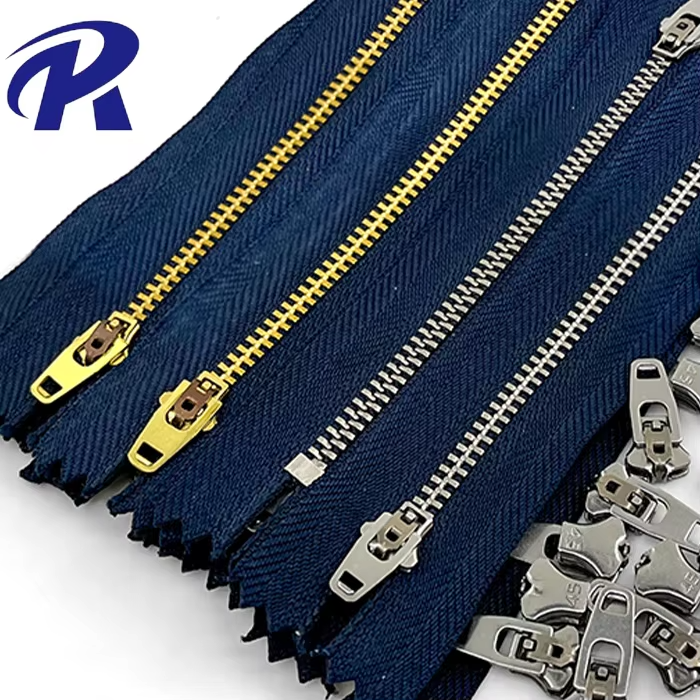The production of metal zippers involves several steps, including raw material preparation, the manufacturing and installation of zipper teeth, slider production and assembly, as well as post-processing and quality inspection. Below is a detailed overview of the process:

1. Raw Material Preparation
- Metal Materials: The teeth of metal zippers are typically made from brass, aluminum, stainless steel, or nickel alloy, chosen for their high corrosion resistance and durability.
- Zipper Tapes: High-strength polyester or cotton fabric is used to produce zipper tapes through weaving or dyeing processes.
2. Manufacturing and Installation of Zipper Teeth
2.1 Tooth Strip Manufacturing
- Stamping: Metal sheets are cut into tooth-shaped pieces using a stamping machine.
- Tooth Shaping: The teeth are further processed with molds to ensure precise tooth shapes and accurate interlocking.
2.2 Tooth Strip Installation
- Embedding Teeth onto Tapes: Metal teeth are embedded into the edges of the zipper tape using specialized equipment.
- Pressing and Fixing: The teeth are secured tightly to the tape with a pressing machine to prevent loosening.
2.3 Heat Treatment
- Heat treatment is applied to the metal teeth to enhance hardness and wear resistance.
3. Slider Production and Assembly
3.1 Slider Manufacturing
- Materials: Sliders are usually made from zinc alloy and are cast using die-casting machines.
- Surface Treatment: The sliders undergo surface treatments such as electroplating, polishing, or spraying to improve appearance and corrosion resistance.
3.2 Slider Installation
- The sliders are attached to the tooth strip, and smoothness is tested to ensure proper functionality.
4. Installation of Top Stops, Bottom Stops, and Pins
- Top/Bottom Stops: Metal top and bottom stops are added to both ends of the zipper to prevent the slider from coming off.
- Pins and Retainers: For open-end metal zippers, pins and retainers are installed to ensure proper alignment and smooth closure.
5. Post-Processing
- Polishing and Cleaning: The metal teeth and sliders are polished and cleaned to remove burrs and production residues.
- Dyeing: Zipper tapes are dyed as per customer requirements.
- Length Cutting: The zippers are cut to specified lengths according to the order.
6. Quality Inspection
- Functionality Testing: Includes interlocking tests for the teeth, smoothness tests for the slider, and tensile strength tests.
- Appearance Inspection: Ensures that the metal teeth are neatly aligned and that the sliders are free from scratches or defects.
7. Packaging and Shipment
- Sorting and Grouping: The metal zippers are coiled or packaged individually.
- Labeling and Shipment: Labels are applied, and the zippers are packed into boxes for delivery.
Advantages of Metal Zippers
- High Strength
- Metal zippers have excellent tensile strength and durability, making them suitable for heavy-duty or high-strength applications, such as jeans, jackets, footwear, and outdoor gear.
- Aesthetic Appeal
- The metallic texture of metal zippers adds a high-end, robust look to products, enhancing their overall quality and style.
- Heat Resistance and Corrosion Resistance
- High-quality metal materials can withstand high temperatures and are resistant to rust and corrosion after electroplating.
- High Smoothness
- The precise manufacturing process ensures accurate interlocking of the metal teeth and smooth slider operation.
- Versatile Designs
- Metal zippers can feature various tooth shapes (e.g., square, round, or pointed teeth) and colors or finishes (e.g., antique brass, silver-plated, gold-plated).
- Wide Range of Applications
- Due to their durability and aesthetic qualities, metal zippers are widely used in clothing, bags, shoes, industrial products, and more.

